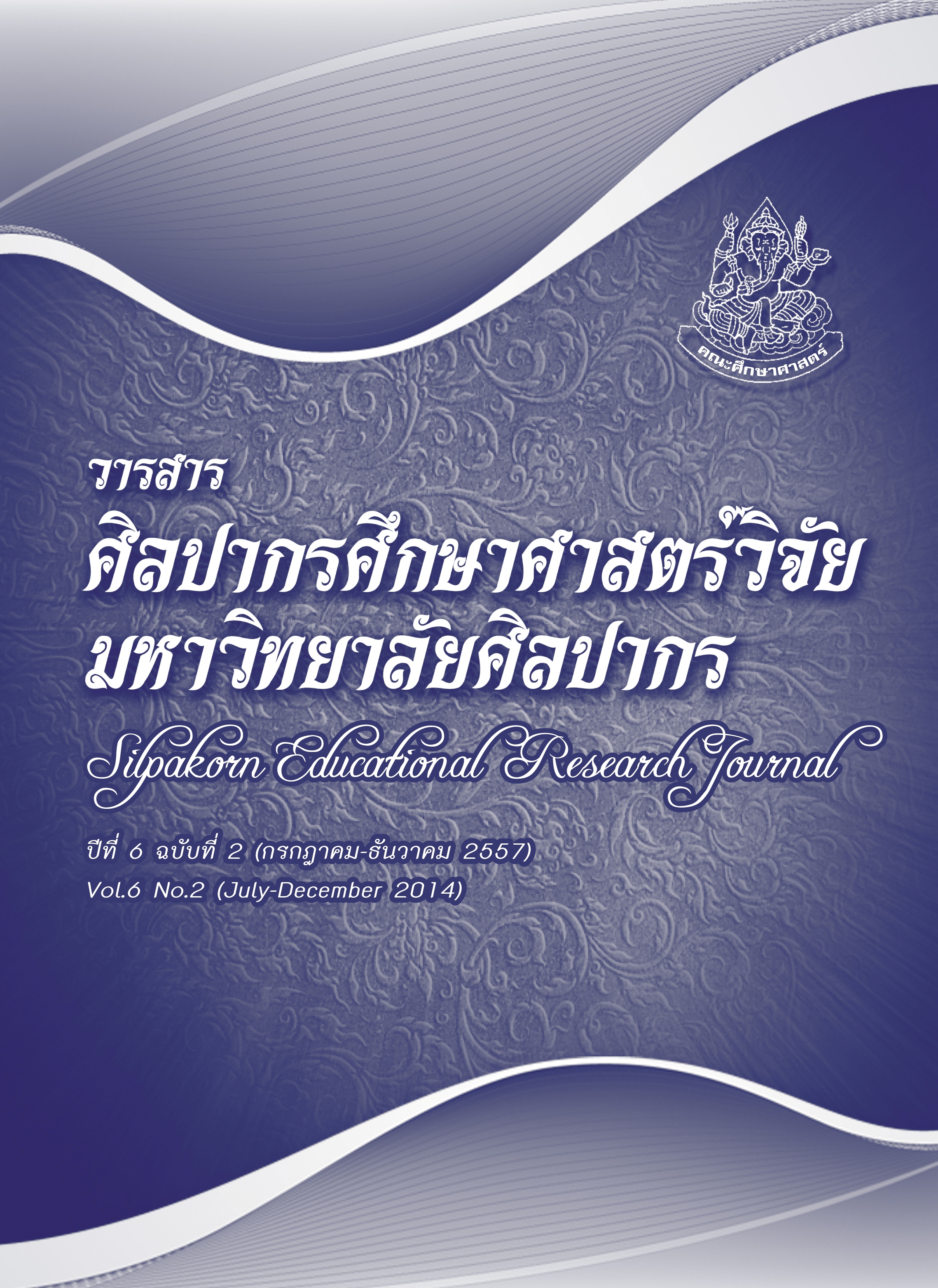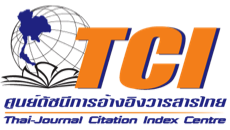ผลของรูปแบบการจัดการเรียนรู้แบบ SSAPA ที่มีต่อการกำกับตนเองของเด็กปฐมวัย
คำสำคัญ:
รูปแบบการจัดการเรียนรู้/ การกำกับตนเอง / เด็กปฐมวัยบทคัดย่อ
การวิจัยนี้มีวัตถุประสงค์เพื่อ 1) สร้างรูปแบบการจัดการเรียนรู้แบบ SSAPA เพื่อพัฒนาการกำกับตนเองของเด็กปฐมวัย และ 2) ประเมินประสิทธิภาพรูปแบบการจัดการเรียนรู้แบบ SSAPA เพื่อพัฒนาการกำกับตนเองของเด็กปฐมวัย มีขั้นตอนดำเนินการวิจัย 4 ระยะ ดังนี้
ระยะที่ 1 การสร้างรูปแบบการจัดการเรียนรู้แบบ SSAPA ซึ่งประกอบด้วยขั้นตอนการเรียนรู้ 5 ขั้นตอนได้แก่ ขั้นตอนที่ 1 การกระตุ้นความสนใจใคร่รู้ (S = Stimulus) ขั้นตอนที่ 2 การสร้างวัตถุประสงค์ในการเรียนรู้ (S = Set up Objectives) ขั้นตอนที่ 3 การลงมือปฏิบัติกิจกรรมเพื่อการเรียนรู้ (A = Active Learning) ขั้นตอนที่ 4 การนำเสนอการเรียนรู้ (P= Presentation) และขั้นตอนที่ 5 การประเมินผลการเรียนรู้ (A = Assessment) ประเมินความเหมาะสมของรูปแบบโดยผู้เชี่ยวชาญ วิเคราะห์ข้อมูลโดยใช้สถิติพื้นฐานค่าเฉลี่ย ค่าเบี่ยงเบนมาตรฐาน
ระยะที่ 2 การสร้างเครื่องมือประกอบการใช้รูปแบบการจัดการเรียนรู้ ประกอบด้วย 1) คู่มือการใช้รูปแบบการจัดการเรียนรู้แบบ SSAPA เพื่อพัฒนาการกำกับตนเองของเด็กปฐมวัย 2) แบบประเมินความเหมาะสมของคู่มือรูปแบบการจัดการเรียนรู้โดยผู้เชี่ยวชาญ 3) แผนการจัดประสบการณ์การจัดการเรียนรู้ 4) แบบประเมินเชิงสถานการณ์พฤติกรรมการกำกับตนเองของเด็กปฐมวัย 5) แบบสังเกตพฤติกรรมการกำกับตนเองของเด็กปฐมวัย และ 6) แบบประเมินผลการใช้รูปแบบการจัดการเรียนรู้โดยครูปฐมวัย ตรวจสอบคุณภาพเครื่องมือในการวิจัยโดยหาความเที่ยงตรงของเนื้อหาและความสอดคล้องกับจุดประสงค์ (IOC) ซึ่งต้องมีค่าดัชนีความสอดคล้องตั้งแต่ 0.60 -1.00 และหาความเชื่อมั่นของการสังเกตโดยใช้วิธีหาค่าดัชนีความสอดคล้อง (RAI : rater agreement indexes)
ระยะที่ 3 การทดสอบประสิทธิภาพรูปแบบการจัดการเรียนรู้แบบ SSAPA ด้วยการสอนนำร่อง รอบที่ 1 กับเด็กปฐมวัยระดับชั้นอนุบาลปีที่ 2 อายุ 5-6 ปี โรงเรียนอนุบาลนครปฐม ที่ไม่ใช่กลุ่มตัวอย่าง
จำนวน 15 คน ปรับปรุงแก้ไขแล้วนำไปสอนนำร่องรอบที่ 2 กับเด็กปฐมวัยระดับชั้นอนุบาลปีที่ 2 อายุ 5 - 6 ปี โรงเรียนอนุบาลนครปฐม ที่ไม่ใช่กลุ่มตัวอย่าง จำนวน 15 คน ทดสอบพฤติกรรมการกำกับตนเองกับกลุ่มตัวอย่างก่อนการทดลอง (Pretest) โดยใช้แบบประเมินเชิงสถานการณ์พฤติกรรมการกำกับตนเองของเด็กปฐมวัย ทดสอบพฤติกรรมการกำกับตนเองกับกลุ่มตัวอย่างหลังการทดลอง (Posttest) โดยใช้แบบประเมินเชิงสถานการณ์พฤติกรรมการกำกับตนเองของเด็กปฐมวัย ในระยะที่ 3 วิเคราะห์ข้อมูลโดยใช้สถิติพื้นฐานค่าเฉลี่ย ค่าเบี่ยงเบนมาตรฐาน และการทดสอบค่าที (T-Test for Dependent Sample) จากนั้นนำรูปแบบการจัดการเรียนรู้แบบ SSAPA ที่ปรับปรุงและพัฒนาแล้วไปใช้กับกลุ่มตัวอย่าง คือ เด็กปฐมวัยชาย – หญิงที่มีอายุ 5 – 6 ปี ระดับชั้นอนุบาลปีที่ 2 โรงเรียนอนุบาลนครปฐม จำนวน 15 คนที่ได้มาจากการสุ่มอย่างง่าย (Simple Random Sampling) โดยใช้วิธีการจับฉลาก เป็นเวลา 8 สัปดาห์ ๆ ละ 4 วัน รวมทั้งสิ้น 32 วัน โดยใช้แบบสังเกตพฤติกรรมการกำกับตนเองของเด็กปฐมวัย สังเกตพฤติกรรมการกำกับตนเองในช่วงสัปดาห์ที่ 2, 4, 6 และ 8 วิเคราะห์ข้อมูลโดยใช้สถิติพื้นฐานค่าเฉลี่ย ค่าเบี่ยงเบนมาตรฐาน
ระยะที่ 4 การขยายผลการใช้รูปแบบโดยครูปฐมวัยที่สอนระดับชั้นอนุบาลปีที่ 2 และ 3 ภาคเรียนที่ 2 ปีการศึกษา 2556 จำนวน 8 คน จาก 3 โรงเรียนสังกัดเขตพื้นที่การศึกษาประถมศึกษานครปฐมเขต 1 ที่ทำการเลือกแบบเจาะจง (Purposive Sampling ) เป็นระยะเวลา 2 สัปดาห์ และประเมินความเหมาะสม วิเคราะห์ข้อมูลโดยใช้สถิติพื้นฐานค่าเฉลี่ย ค่าเบี่ยงเบนมาตรฐาน
ผลการวิจัยมีดังนี้
(1) ผลการสร้างรูปแบบการจัดการเรียนรู้แบบ SSAPA เพื่อพัฒนาการกำกับตนเองของเด็กปฐมวัย ตามความคิดเห็นของผู้เชี่ยวชาญ มีความเหมาะสมอยู่ในระดับมากถึงมากที่สุด ด้วยค่าเฉลี่ย 4.20 – 4.80 โดยผลการประเมินความเหมาะสมของแผนการจัดประสบการณ์การจัดการเรียนรู้แบบ SSAPA เพื่อพัฒนาการกำกับตนเองของเด็กปฐมวัย ตามความคิดเห็นของผู้เชี่ยวชาญมีความเหมาะสมอยู่ในระดับมากที่สุด ด้วยค่าเฉลี่ย 4.60 – 5.00 และผลการประเมินความเหมาะสมของแผนการจัดประสบการณ์การจัดการเรียนรู้แต่ละหน่วยการเรียนรู้ตามความคิดเห็นของผู้เชี่ยวชาญมีความเหมาะสมอยู่ในระดับมากถึงมากที่สุด ด้วยค่าเฉลี่ย 4.40 – 5.00
(2) ผลการทดสอบประสิทธิภาพรูปแบบการจัดการเรียนรู้แบบ SSAPA เพื่อพัฒนาการกำกับตนเองของเด็กปฐมวัย ผลการเปรียบเทียบพฤติกรรมการกำกับตนเองของเด็กปฐมวัยก่อนการทดลอง และหลังการทดลอง พบว่าเด็กปฐมวัยมีระดับพฤติกรรมการกำกับตนเองสูงขึ้นทุกด้านหลังการทดลองโดยแตกต่างกันอย่างมีนัยสำคัญทางสถิติที่ระดับ .01 ผลการทดลองใช้รูปแบบ SSAPA เพื่อพัฒนาการกำกับตนเองเด็กของปฐมวัย มีค่าเฉลี่ยของระดับพฤติกรรมการกำกับตนเองสูงขึ้นทุกด้านอย่างต่อเนื่อง และผลการดำเนินการขยายผลการใช้รูปแบบการจัดการเรียนรู้แบบ SSAPA เพื่อพัฒนาการกำกับตนเองของเด็กปฐมวัย ผลการประเมินความเหมาะสมโดยครูปฐมวัย มีความเหมาะสมอยู่ในระดับมากที่สุด ด้วยค่าเฉลี่ย 4.75 – 5.00
The purposes of this research were 1) to develop a SSAPA Instructional model to improve self–regulation of young children, and 2) to investigate the efficiency of the model. The research methodology consisted of four phases as follows:
Phase I: The SSAPA Instructional Model for improving self–regulation of young children was developed by synthesizing from studying, analyzing, and interviewing of early childhood experts, psychology experts, early childhood teachers, and early childhood parents. The model composed of five learning stages: Stage 1: S (Stimulus), Stage 2: S (Set up Objectives), Stage 3 A: (Active Learning), Stage 4 P: (Presentation), and Stage 5 A: (Assessment). The model was then evaluated by five experts for its appropriateness. The data were analyzed by using means ( ) and standard deviations (S.D.).
Phase II : The research tools which were developed for gathering and analyzing data consisted of 1) the SSAPA Instructional Model 2) the questionnaire for experts to evaluate the appropriateness of the SSAPA Instructional Model 3) the questionnaire for experts to evaluate the appropriateness of the lesson plans of SSAPA Instructional Model 4) the self – regulation behavior observational form 5) the self–regulation behavior situational form and 6) the questionnaire for teachers to evaluate the appropriateness of the model. The research tools were validated by content validity and index of item-objective congruence (IOC), validity was 0.60 -1.00. and To validate the self – regulation behavior observation by the Rater Agreement Indexes (RAI).
Phase III : The efficiency test of the SSAPA Instructional Model was investigated. The model was pilot teaching in the first round with the 15 early childhood students aged 5-6 and modified for the pilot teaching in the second round with 15 early childhood students aged 5-6 studying at Anuban Nakornpathom school, which was the non-sample group. For the pretest, the self–regulation abilities of early childhood was investigated by using the self–regulation behavior situational form. For the posttest, the self–regulation abilities of early childhood was investigated by using the self–regulation behavior situational form. The data were analyzed by using means ( ), standard deviations (S.D.) and t-test for dependent sample. The SSAPA Instructional Model was modified and developed into actual experiment with the 15 second early childhood students aged 5-6 studying at Anuban Nakornpathom school, who were selected by means of simple random sampling. The experiment was conducted during the period of 8 weeks; 4 days per week, with a total of 32 days by using the self–regulation behavior observational form. The data were analyzed by using means ( ) and standard deviations (S.D.).
Phase IV: The SSAPA Instructional Model was used in the actual classroom situations. The model was put into practice by eight teachers of three schools under the Nakornpathom Primary Educational Service Area Office 1, who taught the second or third early childhood students aged 5-6 in the second semester of the 2013 academic year and were selected by purposive sampling method. The experiment was carried out within two weeks. The teachers evaluated the appropriateness of the model. The data were analyzed by using means ( ) and standard deviations (S.D.).
The research results revealed as follows :
1) The appropriateness of the SSAPA Instructional Model according to the experts was at the high to highest levels with the mean ( ) of 4.20-4.80. and The appropriateness of the lesson plan of the SSAPA Instructional Model according to the experts was at the highest level with the mean ( ) of 4.60–5.00, and the appropriateness of the lesson plan of SSAPA Instructional Model in each week according to the experts was at the high to highest levels with the mean ( ) of 4.40–5.00.
2) The efficiency of the SSAPA Instructional Model to improve self–regulation of young children was revealed. The results after the experiment, the self-regulation abilities were higher in all four areas with statistical significant differences at the level of .01 and, after the model was used, the self–regulation behavior was improved constantly, and The appropriateness of the SSAPA Instructional Model according to the teachers, who carried out the experiments with the model were at the highest level with the mean ( ) of 4.75–5.00.





